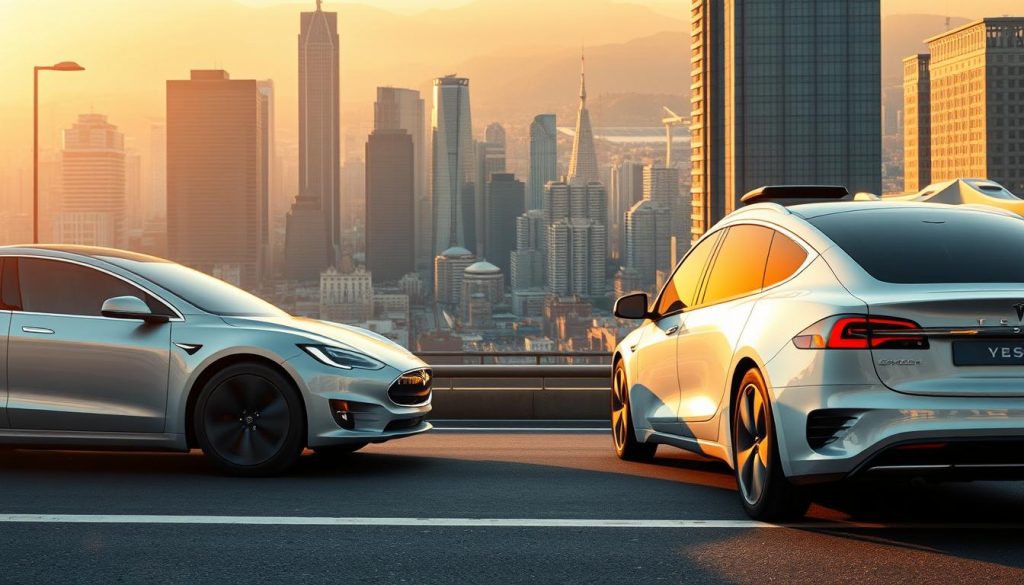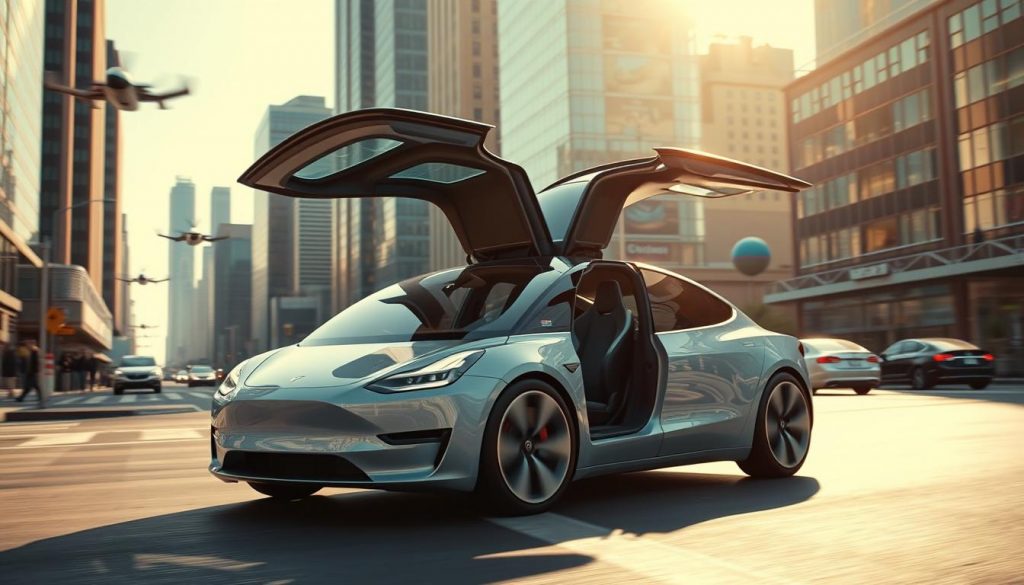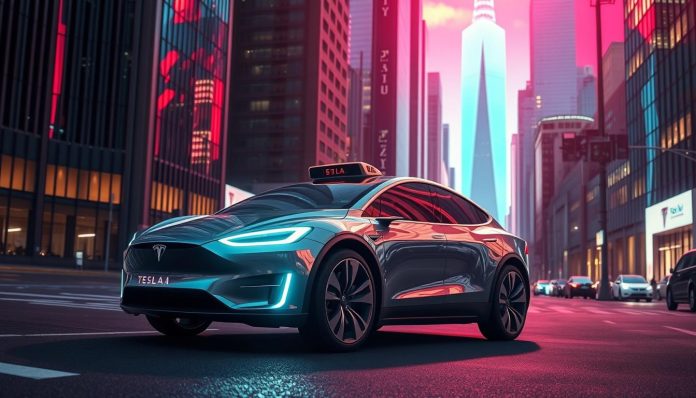Surprising fact: Waymo reports about 250,000 weekly riders across several US cities, a scale that redraws expectations for autonomous mobility and robotaxi services.
On 22 June, a pilot service began in South Austin with supervising human safety drivers in the passenger seat. A broader public launch is set for September, making this a timely moment for analysis and information about the future of rides in this area, particularly as it relates to manufacturing industry news.
This article asks whether Tesla’s vision‑only, end‑to‑end strategy can put the company ahead in an evolving market. It contrasts that approach with rivals that favour sensor redundancy and HD maps over the coming months.
Interest is rising in the UK and beyond as autonomous services expand in US cities. The key tests will be safety validation, scale economics and regulatory acceptance, not announcements alone, as the industry moves towards a new day for self-driving cars.
Key Takeaways
- Tangible pilot launches move discussion from promises to measurable progress.
- Elon Musk’s vision shapes strategy, but overreach remains a risk.
- Technical choices — vision‑only versus sensor redundancy — will affect safety and scale.
- Market leadership depends on regulation, customer trust and unit economics.
- Comparison with Waymo will focus on real‑world ridership, not just tech claims.
Introduction: The Race for Autonomy
Austin became a focal point in June when supervised rides moved from private testing to public streets. On 22 June a pilot began with safety drivers, marking a shift as pilot services leave closed tracks.
Why 2025 counts: this year marks when pilots in major US metros move toward public availability for autonomous vehicles. Waymo continues operations across cities, expanding to Atlanta and serving about 250,000 riders weekly.
Some companies took incremental steps recently, while others announced bolder timelines and now face road tests. Advances in model scale and compute, alongside the latest manufacturing technology, have reshaped end‑to‑end systems’ feasibility over the years.
At the same time, progress will be judged by safety records, uptime, and data quality on busy roads. Austin concentrates engineering and political attention, making it a high‑visibility time to assess whether a vision‑first path can match multi‑sensor stacks used by rivals. This is a pivotal day for the future of autonomous technology.
The Launch: Tesla’s robotaxi pilot in Austin, Texas
From 22 June, a pilot ran on south Austin routes with human supervisors. This marks a shift from promises to visible testing of a robotaxi service ahead of a wider September roll‑out, making headlines in the latest automotive news.
Scope and operation: the trial runs geofenced corridors and invites early users. Each ride is supervised by trained safety drivers who can take control; some supervisors sat in the front seat while monitoring.
Remote support: operators assist vehicles in edge cases — for example, avoiding hazards like trains. This layer complements in‑car supervision and feeds data back into the system.
Customer experience is simple: request a ride via the app, watch a car arrive with no one driving it, and expect swift handover to a human if the system flags an issue. Regulators are being told this remains a supervised feature consistent with Level 2 assistance.
- Test area: predictable streets and supportive infrastructure to reduce complications.
- Success measures for the month: route completion, punctuality, rider satisfaction and incident‑free operation.
- Next steps: scale up vehicles, extend service hours and refine remote assistance procedures.
The Technology Behind the Vision
At core, current self-driving efforts in the automotive industry news rely on a consolidated neural “brain” running on dedicated in‑car chips. This end‑to‑end system folds perception, planning and control into one trainable model, reducing hand‑engineered modules and streamlining updates.
The brain: neural nets and onboard compute
Dedicated hardware runs large networks inside a vehicle. Many customer cars use HW3, while newer releases include HW4 and an eventual HW5. That hardware executes complex models in real time.
Vision‑only versus multi‑sensor stacks
The vision‑only approach trains networks on fleet video. It relies on cameras for scene understanding and reconstructs environments on the fly.
By contrast, multi‑sensor systems fuse cameras, LIDAR and radar with HD maps. That redundancy gives more reliable distance and velocity measurements in poor conditions.
Training, data and current limits
Massive data ingestion from fleet video and large compute farms drives model iteration. The company paused its Dojo focus and shifted training strategies to other compute resources.
Performance has improved, with many trips completed between interventions, yet this remains far from the tens of thousands of trouble‑free trips needed for full self-driving safety.
- Validation is hard: end‑to‑end systems are less interpretable and face distribution shifts.
- Outcome: potential cost and efficiency gains, but a clear gap to reach bet‑your‑life reliability.
| Aspect | Vision‑only | Multi‑sensor | Hardware note |
|---|---|---|---|
| Perception | Real‑time video reconstruction | Sensor fusion with LIDAR/radar | Depends on in‑car chips (HW3/HW4/HW5) |
| Maps | Minimal reliance on HD maps | Map‑centric, updated for service areas | Map updates add operational overhead |
| Safety redundancy | Single modality; relies on model generalisation | Multiple sensors provide fallback | Redundancy increases cost |
The Competition: Tesla vs Waymo
A clear split has emerged: one operator runs mapped, geofenced services across several cities while another tests a vision‑centred fleet in a single metro.

Waymo’s operating footprint
Waymo now offers commercial robotaxis in Phoenix and San Francisco and has expanded into Atlanta. It reports roughly 250,000 weekly rider trips, demonstrating an operational network and customer scale.
Geofenced service areas as a strength
Geofenced zones allow precise HD mapping, focused safety validation and efficient placement of charging and service infrastructure. That targeted approach reduces unpredictable edge cases and improves overall safety.
Hardware stacks compared
Waymo uses a sensor‑rich stack — LIDAR, radar and cameras — plus HD maps. This gives robust ranging and redundancy. By contrast, the Austin pilot relies on cameras alone, aiming to lower per‑car cost and simplify installation.
Who’s ahead today, and why experts disagree
Waymo leads in driverless metrics, but some experts believe a software-centric fleet could catch up by mastering edge cases and unit economics.
“Leadership will hinge on safety, reliability, unit economics, and expansion without friction.”
- Waymo: mature operations, deep mapping, Alphabet’s cloud resources.
- Rival pilot: automotive scale and a global charging network.
Conclusion: current status favours deployed driverless services, but long‑term success relies on safety records, hardware cost reduction, and fleet scalability.
The Safety Debate
Public scrutiny has intensified as regulators and owners press for clearer proof that advanced driver assistance systems reduce harm on real roads with cars in motion.
Human safety matters most. Regulators emphasise that current consumer features are Level 2 assistance and require a person behind the wheel to monitor driving at all times, a necessity that has been underscored over the years.
Human safety, autonomy levels, and supervised FSD
Marketing language can blur what systems actually deliver. That gap shapes buyer expectations about responsibility when a car is moving.
Regulators and experts stress that a supervising driver remains liable for control and intervention.
Legal headwinds
Recent legal developments sharpen the debate. A federal judge in San Francisco certified a class action over claims about Tesla’s self-driving made years ago.
In Miami, a jury awarded $243 million for a 2019 fatal crash and assessed 33% liability to the company. These cases raise questions about how public statements influence liability and oversight.
The Challenges Ahead
Moving from lab validation to busy streets amplifies technical, operational and regulatory stresses on any approach.
The AI‑only approach: faster path or riskier bet?
Pure vision systems try to replace sensors with learning from camera streams. This reduces hardware cost but removes direct range and velocity measures that sensors provide.
Key question: can models and fleet data reach reliability fast enough to match redundant sensor stacks? Delays in model progress cost market share and time to safe scale.
Cybercab and the future fleet
Concepts such as wireless charging and dense service centres promise higher utilisation. Yet no large‑scale wireless network exists today, and retrofit logistics remain complex.
Network effects need rapid deployments and robust service capacity to turn a few cars into a productive fleet.
Will Tesla’s AI Robotaxi Lead the Future of Driving? Find Out Now!
The coming weeks will test whether early pilots can prove reliable across busy urban routes and peak hours.
Signals to watch between now and the wider September launch
Operational metrics matter first: a steady fall in human interventions per completed trip is a clear sign of improved performance.
Consistency across varied routes, better punctuality at peak times, and more vehicles running longer hours will show the pilot is scaling without breaking down.
Transparency is vital: published aggregate safety figures, disengagement rates, and incident reports should go beyond selective anecdotes.

Conclusion
The Austin pilot now provides concrete data points rather than only timelines and claims.
The key takeaway is simple: leadership in autonomous driving depends on proven safety, dependable service and sound unit economics, not just engineering ambition or statements by Elon Musk.
A supervised robotaxi service in Austin is a meaningful step, yet rivals already run driverless robotaxis at scale in places such as San Francisco. That contrast shows how far the company must travel.
Public, audited data on disengagements, collisions, and exposure miles is essential to validate progress and protect human safety. Mixed hardware in the installed fleet creates upgrade and timeline risks.
If the firm can iterate using its large fleet, lean cameras, and an end‑to‑end approach, it could gain a cost advantage. Still, closing the gap may take more than a year and will require transparent reporting.
Conclusion: a Tesla robotaxi could become a major services operator only by proving unsupervised operation at scale with audited metrics. Until that proof arrives, established robotaxis providers retain a clear lead.
For more automotive industry news, please follow the link.,


